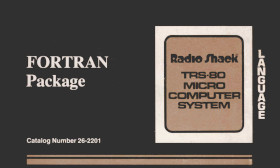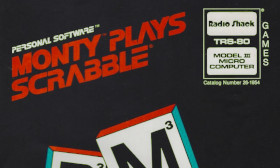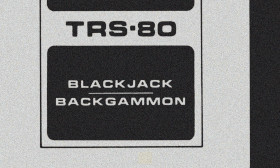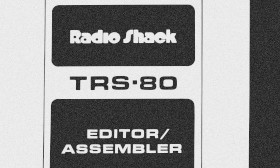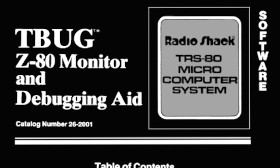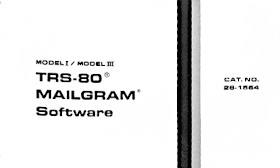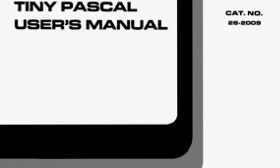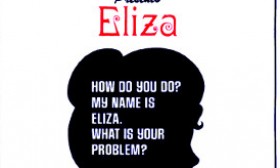Articles in the "Software" Category
Dotwriter was a dot-matrix printing utility, described as a “graphics text formatter.” It supported the TRS-80 Model I, Model III, and later the Model 4. Dotwriter was a highly regarded program: it won the 80 Micro Readers’ Choice Award in 1983 and achieved a perfect score in its 1985 review in 80 Micro.
Dotwriter, which was also styled as DOTWRITER and Dot Writer, was written by William K. Mason. The first version, Dotwriter 1.5, cost $69.95 when it was introduced in 1982. It was originally sold by J.F. Consulting of Palm Desert, California and RCM Computers of Buffalo, New York. Dotwriter 1.5 was written in a combination of BASIC and assembly language.
The much better known versions, Dotwriter 3.0 and 4.0, were sold by Prosoft of North Hollywood, California. (Prosoft also sold the Newscript word processor frequently mentioned in the Dotwriter 1.5 manual.) Dotwriter 3.0 was introduced in 1983 for $79.95. Dotwriter 4.0, which was a complete rewrite in assembly language and four times faster than Dotwriter 3.0, was released in 1984. It cost $79.95 for the Model I and III version and $99.95 for the Model 4 version.
(Read more...)
Microsoft FORTRAN, also known as FORTRAN-80, was one of the most advanced programming tools available for the TRS-80. As a compiled language, it was more powerful than the included BASIC interpreter. Microsoft FORTRAN was created and sold by Microsoft for multiple TRS-80 models, although the most popular versions were sold directly by Radio Shack. Many commercial TRS-80 programs, such as The Mean Checkers Machine by Lance Miklus, were written in FORTRAN. Miklus wrote in the March 1980 issue of The S-Eighty:
FORTRAN’s advantages are numerous: it’s fast, the coding technique is protected, it has powerful library functions, it is an excellent number cruncher, its functions are complete subroutines instead of single lines, and it interfaces easily with machine language subroutines.
(Read more...)
Monty Plays Scrabble (catalog number 26-1954) by Ritam Corporation of Fairfield, Iowa was a sequel to their earlier Monty Plays Monopoly. It cost $34.95 and was released in 1982 for the 32K disk TRS-80 Model III. Ritam also sold a version of Monty Plays Scrabble for the Apple II. Other than color, the Apple II version was nearly identical to the TRS-80 version.
Like Monty Plays Monopoly, Monty Plays Scrabble was a “computer opponent program” allowing up to four people to play Scrabble against their computer. Unlike it, Monty Plays Scrabble was officially licensed by Selchow and Righter Co., the Scrabble trademark holder at the time. (The manual identifies the title of the game as “Monty Plays the SCRABBLE Brand Crossword Game.”)
(Read more...)
By 1979, the TRS-80 Model I was regarded as having the largest software library of any microcomputer on the market. But when the Model I was introduced in 1977, it had only five pieces of software available. Only one of those was bundled with the computer: Blackjack/Backgammon, also known as Game Package.
Radio Shack’s original August 1977 press release for the TRS-80 mentioned that “a variety of game programs will be available, including blackjack and backgammon.”
(Read more...)
The TRS-80 Editor/Assembler (catalog number 26-2002), better known as EDTASM, was an assembly language programming tool for the cassette TRS-80 Model I. It was introduced in 1978 and cost $29.95. EDTASM was such a common tool that its name (and associated file format) became a kind of shorthand for TRS-80 assembler.
EDTASM was written by Mark Chamberlin of Microsoft and licensed to Radio Shack. A Radio Shack catalog stated:
Microsoft, an industry leader in systems software, has developed this program … so you can expect the ultimate in editing features.
(Read more...)
Monty Plays Monopoly was a “computer opponent program” that allowed a TRS-80 owner to play the popular Monopoly board game. There were two TRS-80 versions of Monty Plays Monopoly:
- The original 1980 version by Ritam Corporation of Fairfield, Iowa, which was available for the 16K cassette and 32K disk Model I. This version was distributed by Personal Software. (Personal Software, later renamed VisiCorp, was better known for their VisiCalc spreadsheet.) Ritam also sold a version for the Apple II for both cassette and disk.
- Ritam Corporation also licensed Monty Plays Monopoly through Personal Software to Tandy Corporation. This version (catalog number 26-1952) cost $34.95 and was released in 1982. It was only available for the 32K disk Model III. This is the most common TRS-80 version.
Unlike later Monopoly programs, Monty Plays Monopoly wasn’t designed to replace the board game but to supplement it. In fact, it requires “the board and all the equipment that comes with the game”, according to the manual.
(Read more...)
T-BUG (catalog number 26-2001), also known as TBUG, was a machine language monitor and debugger for the TRS-80 Model I. It cost $14.95 and came on a cassette with separate versions for Level I and Level II BASIC. (The T-BUG debugger shouldn’t be confused with the Tandy Business Users Group, which was also known as T-BUG.)
Described by some as the “standard” TRS-80 debugger, T-BUG provided an inexpensive way for TRS-80 owners to learn about and experiment with assembly language. Most books about TRS-80 assembly language, such as Earles L. McCaul’s TRS-80 Assembly Language Made Simple and William Barden’s TRS-80 Assembly Language Programming, assumed that the reader owned T-BUG.
(Read more...)
TRS-80 Mailgram (catalog number 26-1564) was a software package that allowed sending Western Union Mailgram messages directly from a TRS-80 Model I or Model III. It was introduced in late 1979 and cost $39.95, not including a Western Union account (which cost an additional $50.00) and per message fees.
The Mailgram service was introduced by Western Union in 1970. Mailgram worked by transferring digital messages to a location closer to the recipient, printing them out, and then mailing them using the postal mail. The process was described this way in a Western Union advertisement from a 1972 Life magazine:
Just call a number shown below (toll-free from most phones). Western Union will transmit your message electronically to a post office near your addressee. And the next business day your Mailgram will be delivered by regular letter carrier.
(Read more...)
Tiny Pascal, also known as “Tiny” Pascal, was a popular programming language for microcomputers. It was created by Kin-Man Chung and Herbert Yuen in 1978 and first described in a three-part series of articles published in BYTE. There were at least four different versions of Tiny Pascal for the TRS-80, although the version sold by Radio Shack was the most popular.
Tiny Pascal was a subset of the programming language Pascal. It contained most of the features of Pascal but was small enough to run well on a cassette-based TRS-80. Tiny Pascal was often used to teach Pascal programming and the Radio Shack catalog described it as a “great introduction to structured programming.”
The first version of Tiny Pascal appeared in a three-part series of articles in BYTE titled “A ‘Tiny’ Pascal Compiler.”
(Read more...)
Eliza (catalog number 26-1908), also known as Talking Eliza, was a TRS-80 Model I and Model III implementation of Dr. Joseph Weizenbaum’s famous ELIZA program. It was introduced by Radio Shack in 1979 for a price of $14.95. Eliza was written by Robert A. Arnstein and was licensed to Radio Shack through his company, Device Oriented Games. One unusual feature of the program was its ability to speak its responses using Radio Shack’s TRS-80 Voice Synthesizer, hence the name Talking Eliza.
The original ELIZA program was created by Dr. Joseph Weizenbaum. He described it in an article “ELIZA – A Computer Program For the Study of Natural Language Communication Between Man and Machine” that was published in the Communications of the ACM in January 1966:
(Read more...)
EnhComp was a BASIC compiler written by Philip Oliver for the TRS-80 Model III and Model 4. (Longtime TRS-80 users probably remember Philip Oliver for his excellent game
Scarfman.) Oliver wrote two versions of EnhComp: the original published by the Cornsoft Group of Indianapolis, Indiana in 1980 and the more popular second version (whose full name was the Enhanced BASIC Compiler Development System) sold by MISOSYS of Sterling, Virginia starting in 1986. Unlike most other TRS-80 BASIC compilers (such as Simutek’s ZBASIC), EnhComp wasn’t primarily focused on compatibility with interpreted BASIC but on providing a new enhanced version of BASIC.
(Read more...)
ED-IT for the Model 4 is a very powerful text editor for the TRS-80 Model 4. It was written by Mark Reed and was first released on June 17, 1991. ED-IT cost $17.95 and was distributed by Computer News 80 of Casper, Wyoming.
There were many capable editors for the Model 4. Most Z80 assembler packages included their own editors (ALEDIT in ALDS and SAID in MRAS were notable examples). The LS-DOS 6.3 operating system even included a simple text editor named TED/CMD.
But ED-IT contains many useful features for programmers and is suitable for use with multiple programming languages or simple word processing. Despite its many features, it has one of the largest text buffers of any Model 4 editor. As Harold J. Hendriks wrote in the January 1996 issue of Computer News 80:
ED-IT is the CHAMP when it comes to editing large files. It can accept, load and edit ASCII text files up to 47K in size.
(Read more...)
The File Cabinet was the largest collection of TRS-80 public domain and shareware software ever assembled. At its height, it was described as offering “15,000 programs for the Model I/III/4/4P/4D.” Disks from the collection were sold from 1987 to 2009.
The File Cabinet was started in 1987 by Tim Sewell, a sysop of the Tandy RoundTable on the GEnie online service. It began as Sewell’s collection of TRS-80 files submitted to GEnie and that he had downloaded from BBS’s around the country. He described the File Cabinet as a “hobby that I enjoy doing” in the November 1989 issue of Computer News 80:
The File Cabinet was created out of a love for this computer and the chance through magazines who believed in my project to get software into the hands of the people who don’t have access to or use a modem to call BBS systems.
(Read more...)
When the TRS-80 Model I was introduced on August 3, 1977, it came with Level I BASIC, a 4K BASIC interpreter, in ROM. Level I BASIC was created by Steve Leininger, the designer of the TRS-80, who based it on the public domain “Palo Alto Tiny BASIC” that Dr. Li-Chen Wang wrote in 1976.
But Radio Shack’s plan was always to upgrade to a more advanced Model I BASIC later. The very first TRS-80 brochure said that “planned expansion includes an extended Radio Shack Level II BASIC.” It was mentioned again in the first issue of the TRS-80 Microcomputer News (then known as the Radio Shack Microcomputer Newsletter) in 1977:
A Level II BASIC is now being developed. This will be a 12K BASIC with every feature you ever imagined – PEEK and POKE, PRINT USING, transcendental functions, advanced string handling, etc. It should be available on ROM soon.
(Read more...)
Most people considered the Big Five Software games to be the finest games ever written for the TRS-80 Model I and III. They were sold directly through Big Five Software and were resold by many other companies.
Radio Shack also sold Big Five Software games in two collections compiled by Cogito Software. Games Pack Two and Games Pack Three first appeared in the 1984 Radio Shack catalog and contained four Big Five games: Defense Command, Stellar Escort, Cosmic Fighter and Meteor Mission 2. As the packaging stated: “You can look forward to hours of fun for the family, friends, or even the gang at the office.”
Both collections were sold on cassette and self-booting disk. Only minor modifications were made to the games, the biggest being that all copyright messages were changed to “Licensed to Tandy Corporation.
(Read more...)
PRO-WAM (also known as PRO-NTO) is a collection of pop-up tools for LS-DOS/TRSDOS 6 on the TRS-80 Model 4. It was written by Karl Hessinger and Roy Soltoff and cost $59.95 when it was introduced in December 1984.
PRO-WAM was one of the few programs to require a Model 4 expanded to a full 128K of memory. In my opinion, it was one of the best uses of the extra memory and one of my favorite Model 4 utilities.
PRO-WAM was described in advertisements as a “Window Controller and Applications Manager.” It was inspired by the Borland program Sidekick, a terminate and stay resident personal information manager that was very popular at the time on the IBM PC. (PRO-WAM was also similar to Monte’s Window, written by Jim Stutsman, which was only available for Montezuma Micro CP/M.) Like Sidekick, PRO-WAM provided a set of simple, but useful, tools that could be popped up over a running program.
(Read more...)
AIDS-III, also known as MTC AIDS-III, was a very popular database system for the TRS-80 Model I, III, and II. Its unfortunate name (in retrospect) stood for Automated Information Directory System. AIDS-III was a highly regarded program and final member of the family of AIDS products.
Robert Fiorelli, the primary author of AIDS-III, described it not as a “database management system” but as a “data-management system”:
AIDS-III is a data-management system. This is different from a data-base management system. The former is generally faster, more flexible, and is suited for selecting and ordering information in a highly dynamic fashion. By contrast, the latter has higher capacity, is slower and more cumbersome, and is suited for easily accessing individual items of data. Think of it as the difference between driving a station wagon and a bus.
(Read more...)
Microsoft Multiplan was an early spreadsheet program and the first piece of application software from Microsoft to target end users. It was introduced in 1982 with versions for CP/M, MS-DOS, and the Apple II. Versions for many other computers, including various TRS-80 models, soon followed. Multiplan was the first (and for a while the only) third-party software package available when the Apple Macintosh was introduced in 1984.
Multiplan (sometimes called the Multiplan Electronic Worksheet) was a “second generation” spreadsheet, designed to compete with VisiCalc, the original (and incredibly popular) spreadsheet program. Multiplan was written by Douglas Klunder under the direction of Charles Simonyi, the head of Microsoft’s new application software group.
(Read more...)
In the early days of microcomputers, many considered learning Pascal to be the logical next step for beginning programmers after learning BASIC. Alcor Pascal, sold by Alcor Systems of Garland, Texas, was a “complete Jensen and Wirth Standard Pascal” and a popular choice for TRS-80 users who wanted to expand their programming horizons.
In addition to the TRS-80 versions (which cost $199.00), Alcor Systems also sold Alcor Pascal versions for CP/M (including the Apple II with the Microsoft CP/M SoftCard) and later on for MS-DOS computers. Starting in 1983, Radio Shack began selling licensed versions of Alcor Pascal for the Model I/III (catalog number 26-2211) and the Model 4 (catalog number 26-2212). Both versions cost $249.95
Alcor Pascal had its origins in 1978 as a Pascal compiler for CP/M systems, a history that was detailed in the first issue of the Alcor Systems Newsletter in 1982:
(Read more...)
Pascal 80 was a Pascal development system for the TRS-80 Model I, III, and 4. It was written by Phelps Gates, also the author of APL-80, an APL compiler for the TRS-80.
The Pascal 80 package consisted of a full-screen text editor, monitor, and compiler. Pascal source code could be compiled directly to memory or to disk. Editing and compiling Pascal source code in memory made programming Pascal similar to using interpreted languages, such as BASIC. According to the Pascal 80 manual:
Efficient and compact code allows Pascal 80 to have a monitor, editor, and compiler in the computer at the same time, yet leave enough room to create programs up to 23K bytes, with an additional 9K available while the program is running for variables and work space. This allows programs to be written, compiler, edited, and compiled again without time consuming disk access.
When written to disk, resulting programs could either be created as p-code (an intermediate compiled format) or could be merged into standalone /CMD files.
(Read more...)
Zorlof the Magnificent was a powerful word processor for the TRS-80 Model I and III. It was written by Peter Ray and sold by Anitek Software Products of Melbourne, Florida. Released in 1982 for a price of $69.95, Zorlof was often described as a “second-generation word processor,” one generation beyond Electric Pencil and Scripsit.
Zorlof was a full-screen word processor that supported lowercase on the Model I. It provided 61 editing functions, which included common tasks such as deleting lines, global search and replace, and block moves. Word-wrapping and justification were automatically handled by Zorlof. As it stated in the manual:
(Read more...)
MULTIDOS was one of the major TRS-80 operating systems, described in advertisements as “the most compatible, user friendly operating system on the market.” It was written by Vernon Hester, the author of ULTRADOS, and was in some ways a continuation of that operating system. MULTIDOS was the least expensive TRS-80 operating system and also the one with the most recent update (MULTIDOS 5.1 in 2005). It was also the only TRS-80 operating system to offer software compatible versions for the TRS-80 Model I, Model III, Model 4, and the Lobo MAX-80.
ULTRADOS was an earlier TRS-80 operating system for the Model I that was sold by Level IV Products. After Vernon Hester parted ways with Level IV Products in 1981, he began writing a completely new operating system. This operating system, which was briefly advertised as ULTRA-II, soon became known as MULTIDOS. Vernon Hester originally sold MULTIDOS through his company, Cosmopolitan Electronics Corporation. The Model I version of MULTIDOS was released in late 1981 and the Model III version was released in January 1982. The price started out at $79.95 but soon increased to $99.95. Later on, MAX-80 MULTIDOS was released in late 1983 and Model 4 MULTIDOS (originally known as MULTIDOS 80/64) in 1985.
(Read more...)
M-ZAL was a powerful disk-based editor assembler system for the TRS-80 Model I and III. First introduced in 1981, M-ZAL (which stood for Modular Z80 Assembly Language) was written by Jeffrey Krantz and David Willen. It was sold by Computer Applications Unlimited (also known as CUA) for the price of $149.95.
Although expensive, M‑ZAL was one of the most advanced assemblers ever written for the TRS-80 and it was used by many professional TRS-80 developers. The advertisements contained endorsements from several TRS-80 authors, including:
(Read more...)
Level III BASIC was an enhanced version of Level II BASIC for the TRS-80 Model I. It was created by Microsoft, also the authors of Level II BASIC, but sold by GRT Corporation on cassette for $49.95. Level III BASIC was said to be the first consumer product from Microsoft, which had previously sold only to manufacturers.
Rather than sell Level III BASIC directly to consumers, Microsoft decided to release it through GRT Corporation in 1978. GRT Corporation, which stood for Great Records and Tapes, was a music company that had expanded into the software business. The GRT software division, named G2, was started by Vern Raburn and Level III BASIC was sold under the G2 label.
The Level III BASIC manual contains this surprising statement of authorship:
(Read more...)
PC-Four was the first TRS-80 Model 4 emulator for IBM PC compatible computers. It was written by Michael Gingell and introduced by Hypersoft in mid-1987 for a price of $79.95. PC-Four required a computer with at least 384K of memory and worked on both floppy and hard drive systems.
PC-Four (sometimes referred to as PC4) was quite different than later TRS-80 emulators. It achieved most of its compatibility not through Model 4 hardware emulation but by emulating the Model 4 operating system. This approach (similar to the MS-DOS emulator DOSBox today) allowed PC-Four to approximate Model 4 speed when running on a Tandy 1000 SX. The PC-Four manual described it this way:
(Read more...)
In late 1982, PowerSOFT began advertising the “Super Utility Plus Special Edition.” The package, sometimes referred to as “Super Utility Plus S/E,” was a premium limited-edition version of Super Utility. Only 500 packages were produced and each cost $500.00, including shipping. PowerSOFT took reservations for several months and began shipping on January 20, 1983.
Each Special Edition was numbered (1 to 500) and each was personally signed by Kim Watt. In addition to the Super Utility manual, it also came with two books:
(Read more...)
I suspect that almost everyone who used a TRS-80 disk system remembers Super Utility. First released by Kim Watt in 1980 through his company Breeze Computing, Super Utility was regarded by many to be an indispensible tool. It was described in advertisements as “The King of Utilities” and readers of 80 Micro must have agreed; they voted it 1st Place in the utility category for both the 1982 and 1983 Readers’ Choice Awards. According to one source, a copy of Super Utility was a required purchase for all United States government offices with a TRS-80.
In all, there were versions of Super Utility for the TRS-80 Model I, III, and 4, the Lobo MAX-80, and the IBM PC. I think William D. Allen said it well in a 1983 review in 80 Micro:
This program is like a fire engine. You don’t need it every day, but when you do nothing else will do the job.
(Read more...)
The CHROMAtrs was a TRS-80 Model I and III add-on that could display color text and graphics on a separate monitor or television. The CHROMAtrs had advanced graphics and sound features, but using those features required low-level programming that was beyond the abilities of many people. That all changed with the introduction of CHROMA BASIC.
CHROMA BASIC was written by Robert French, who was 14 years old at the time. It added over 68 commands to BASIC to manipulate the graphics, sound, and joystick features of the CHROMAtrs. Although originally priced at $30.00, CHROMA BASIC was soon bundled with the CHROMAtrs package and prominently featured in the advertisements.
(Read more...)
VisiCalc is one of the most important programs ever created for microcomputers. It was not only the first spreadsheet program but is also generally regarded as the first “killer app.” It was the top selling program for four years, selling more than 200,000 copies in its first two years alone. Its popularity helped to drive early personal computer sales; many people bought a personal computer just to use VisiCalc.
Dan Bricklin came up with the idea for an “electronic spreadsheet” while still a graduate student at Harvard Business School. He and Bob Frankston founded Software Arts, Inc. in 1979 to explore the idea and VisiCalc was the result.
First demonstrated at the National Computer Conference in June 1979, the Apple II version of VisiCalc was shipped on October 17, 1979. Although developed by Software Arts, VisiCalc was sold by Personal Software (later VisiCorp), a company founded in 1976 by Dan Fylstra and Peter Jennings.
VisiCalc for the Apple II was so successful that versions for other computers were inevitable. The initial targets were the Commodore PET, the Atari 800, and the TRS-80 Model I. The Commodore PET and the Atari 800 shared the same 6502 processor as the Apple II and could use the same VisiCalc code. But the TRS-80 version required converting the VisiCalc code to use the Z80 processor, a project undertaken by Seth Steinberg. Despite this, both the Atari 800 and TRS-80 versions were released in late 1980, almost a year after the release of the Apple II version.
(Read more...)
TRS-Opera, written by Richard Taylor, was an early TRS-80 music program. It was distributed by Acorn Software and sold for $9.95.
TRS-Opera is a BASIC program with an embedded machine language sound routine. The sound routine plays notes through the TRS-80 cassette port very rapidly, simulating more than one note at a time. The “opera” part of the name derives from the choice of music included with the program:
(Read more...)
DoubleDuty is a utility that uses the full 128K of a TRS-80 Model 4 to allow more than one program to be run at one time. Introduced by Radio Shack in 1984, DoubleDuty was written by Randy Cook, the author of Model I TRSDOS and VTOS.
DoubleDuty works by creating three sections, called partitions, out of the Model 4 memory. Partitions one and two each contain a complete Model 4 TRSDOS system. The third partition is reserved for running TRSDOS library commands.
(Read more...)
VTOS (which stood for “
Virtual
Technology’s
Operating
System”) was the second TRS-80 Model I operating system created by Randy Cook, the author of Model I TRSDOS. VTOS was released in 1979 and sold through Randy Cook’s company, Virtual Technology Inc. The original price was $49.95 for VTOS version 3.0. That was increased to $99.95 for version 4.0, or $125.00 for VTOS plus Operator’s Guide and Master Reference manual. There doesn’t appear to have been a Model III version of VTOS.
(Read more...)
Wayne Westmoreland and Terry Gilman wrote some excellent games for the TRS-80 from 1981 to 1983, including Sea Dragon and Armored Patrol. In 1995, Wayne Westmoreland released all of those games into the public domain.
Here is a description, written by Wayne Westmoreland in 1995, for each of the games.
(Read more...)
After upgrading their TRS-80 Model I to Level II BASIC, many people missed the “shorthand dialect” of Level I BASIC. TSHORT was a very popular keyboard macro utility for Level II BASIC that added a similar kind of shorthand for BASIC commands. It was written by Ron Wirth and released in 1979 by Web Associates for $9.95. (The name Web Associates was not a reference to the World Wide Web, which it predated by ten years.) TSHORT ran in high memory above BASIC and consumed only 580 bytes of memory.
(Read more...)
When the TRS-80 Model I was first released in 1977, the BASIC interpreter that Microsoft was writing, Level II BASIC, was still months away from completion. Instead the Model I originally shipped with a BASIC interpreter known as Level I BASIC.
Level I BASIC was based on “Palo Alto Tiny BASIC”, a 2K version of Tiny BASIC written by Dr. Li-Chen Wang for the May 1976 issue of Dr. Dobb’s Journal. Because Dr. Li Chen-Wang placed his BASIC in the public domain (he labeled it “@COPYLEFT; ALL WRONGS RESERVED”), Steve Leininger, the designer of the TRS-80, was able to use it as a starting point. He added floating point math, cassette, keyboard, and video routines, doubling the size of the original code to 4K.
(Read more...)
Rally was written by J. Weaver Jr. (Factory Programming) and distributed by Soft Sector Marketing. Rally was based on Rally-X, which was released by Namco in 1980.
The goal in Rally is to collect all of the flags in a maze, while avoiding “enemy cars”. Touching an enemy car causes you to lose your life.
(Read more...)
ZBASIC is probably the most popular BASIC compiler ever written for the TRS-80. It holds the distinction of being one of the few programs originally created for the TRS-80 that is still being developed in some form.
The first version of ZBASIC was written in 1979 by Andrew Gariepy for the Model I and sold by Simutek Computer Products. ZBASIC began appearing in Simutek advertisements in 1980. It originally cost $99.00 for the tape version and $129.00 for the disk version.
ZBASIC fell somewhere between a traditional compiler and an interpreter. As an early advertisement described it:
(Read more...)
Devil’s Tower was written by John Olsen and released by Fantastic Software in 1982.
The player starts the game on the left, separated from the Attackers by a tall mountain in the center of the screen. The goal is to shoot over the mountain and destroy the Attackers on the other side. To complicate matters, the Attackers shoot back at you, often displaying an uncanny ability to predict where you are moving.
(Read more...)
Scarfman was based on the arcade game Pac-Man, which was released by Namco in 1980. It was written by Philip Oliver and distributed by the Cornsoft Group. The Cornsoft Group also released a version of Scarfman for the Color Computer.
The game starts with you (the “Scarfman”) at the bottom of the screen. Like Pac-Man, the goal of Scarfman is to eat all of the dots on the screen. You earn points for every dot eaten.
(Read more...)
Android Nim was Leo Christopherson’s first game for the TRS-80. It was featured on the cover of 80-Northwest Journal (later 80-U.S. Journal) in November 1978 and was released by 80-NW Publishing (later 80-U.S. Software). The cost was $8.00 for cassette and $13.00 for disk, with a $2.00 discount for 80-Northwest Journal subscribers. The game helped to popularize the magazine, and 80-U.S. Journal used an android for its mascot until 1981.
Soon after the original release, Leo Christopherson enhanced Android Nim with sound and more animation, developing the techniques known as “string-packing” and “line-packing” in the process. The enhanced version of Android Nim cost $14.95. Like all of Leo Christopherson’s TRS–80 games, Android Nim was written in combination of BASIC and machine language.
(Read more...)
TRSDOS 2.0 was the first version of Model I TRSDOS to be released to the public. All earlier versions had been used for testing within Radio Shack only. It came with a preliminary instruction manual, with a final manual promised for the near future. Not many people used TRSDOS 2.0 because it was replaced by TRSDOS 2.1 after only a short time.
(Read more...)
Model I TRSDOS Disk BASIC contained a number of extra commands and enhancements to Level II BASIC, not all related to disk. The commands were documented in the TRSDOS 2.3 Reference Manual. All other TRS-80 operating systems with a Disk BASIC supported these commands, although often
CMD and
NAME used different syntax.
(Read more...)
The Model I TRSDOS command shell supported a number of internal commands, as documented by the TRSDOS 2.3 Reference Manual. Most of the commands were also supported by other TRS-80 operating systems, although they usually added extra features beyond the TRSDOS versions.
(Read more...)
TRSDOS, referred to as DOS in some early references, was Radio Shack’s official disk operating system for the Model I. The name stood for
Tandy
Radio
Shack
Disk
Operating
System. It was bundled with Radio Shack’s floppy disk upgrade, but it could also be purchased separately.
(Read more...)
Although there were many Frogger adaptations for the TRS-80, this Cornsoft Group version was licensed by Sega and was the “official” Frogger. The premise of Frogger is simple. The goal is to guide as many frogs as possible back to their homes, crossing a busy road and dangerous river in the process.
The TRS-80 version of Frogger offers the choice of five difficulty levels and an option to play background music. The famous theme music, taken from the Japanese children’s song “Inu No Omawarisan”, is the same as used in the original arcade version. Most TRS-80 games played music during title screens and sound effects during the game. Frogger was one of the few to also play background music during the game, not an easy feat on a computer with no sound controller.
(Read more...)
Outhouse is probably the TRS-80 game with the most bizarre premise. It was written by J. Weaver Jr. (Factory Programming) and distributed by Soft Sector Marketing.
Outhouse was later rewritten for the Color Computer by the same author, but sold through Computer Shack.
(Read more...)
The T80-FS1 Flight Simulator was a groundbreaking simulation program for the TRS-80, written by Bruce Artwick and released by SubLOGIC in February 1980. It was based on A2-FS1, the original Apple II version of the Flight Simulator, also written by Bruce Artwick and released a few months earlier. From the introduction to the T80-FS1 user’s manual:
The T80-FS1 is the second version of the FS1 program. Feedback from users of our initial Apple II version of FS1 has been used extensively in the TRS-80 version. Selectable downward view, bomb sights, visible enemy gun blasts, and a “simulation reset” command were all added to the FS1 since the introduction of the Apple II FS1. The T80-FS1 also has slightly higher frame projection rate than the Apple version.
(Read more...)
Nukliex was written in 1984 by Dennis Lo, and released through JMG Software International. Although the game’s title screen identifies itself as “Nukliex”, it was always advertised as “Nucliex”.
When you start Nukliex, you can select a difficulty level between 1 and 10. You control a ship located at the bottom of the screen that fires shots toward the top. Asteroids and aliens attack you from above. This is pretty standard for most games of this type. But unlike other games, you can also move your ship not just side to side but also up and down. Your ship also has a shield that will protect it when you press the ENTER key. The shield takes time to regenerate itself, so you need to use it sparingly.
(Read more...)
Apple Panic was based on the arcade game
Space Panic, released by Universal in 1980. The original version was written for the Apple II by Ben Serki in 1981 and sold by Brøderbund Software. There were also versions of
Apple Panic sold for the Atari 400/800 and the IBM PC (both written by Olaf Lubeck) and for the Commodore VIC-20 (by Creative Software). The TRS-80 version was written by Yves Lempereur in 1982 and published by Funsoft, the fifth of nine games that he wrote for the TRS-80.
(Read more...)
Galaxy Invasion Plus was an update to
Galaxy Invasion with a few new features added. An important difference from the older game is the voices. The speech include “Galaxy Invasion” (at the title screen), “Prepare to die, human!” (as the game starts), and “Game over, Player 1” (when the game ends). Other phrases that are used include: “You’re dead!”, “Flagship alert!”, and “Extra ship!” If you achieve a high score, the game says, “Great Score, Player 1”. But if you beat the top score, it says “Super Score, Player 1”. The speech is very clear and one of the best examples of voice in a TRS-80 game.
(Read more...)
Weerd was written by Arthur Gleckler and released in 1982. It was the final TRS-80 game released by Big Five Software, and only one of two not written by Bill Hogue.
Weerd was released near the very end of the TRS-80 game market.
(Read more...)
Defense Command was the last TRS-80 game written by Bill Hogue. It was very loosely based by the arcade game Defender, which Williams Electronics released in 1980.
Defense Command has the best and clearest voices of any Big Five Software game. It also has very clever graphics and transitions between different screens. In my opinion, Defense Command is the most impressive of the Big Five Software games for the TRS-80.
(Read more...)
Stellar Escort was written by Jeff Zinn, and it was the first game distributed by Big Five Software that wasn’t written by Bill Hogue.
Stellar Escort has a very distinctive look because of the flashy transition effects when changing screens. There is always something in movement on the screen.
Stellar Escort has a number of sound effects, but no music or voices.
(Read more...)
Cosmic Fighter was loosely based on
Astro Fighter, which was released by Data East in 1980. In many ways, Cosmic Fighter looks similar to
Galaxy Invasion. However, the similarities are superficial and the games are very different. Your goal in
Cosmic Fighter is to shoot the aliens as they descend from the top of the screen. Unlike
Galaxy Invasion, you have a limited fuel supply which is used up as you move and shoot. A gauge at the top of the screen indicates how much fuel you have left. Your ship can be destroyed either by hitting an alien or shot or by simply running out of fuel. You are not likely to run out of fuel in the earlier levels of the game, but it does becomes an increasing problem in the later levels.
(Read more...)
Many people remember the distinctive prelude to
Attack Force, which was obviously inspired by the opening to the
The Outer Limits television show. The final part of the prelude takes the video screen out of focus and makes a buzzing sound (without any audio amplifier attached). This effect is created by rapidly switching between normal and double-wide video mode, destabilizing the video synchronization on a Model I or III. The Model 4 features a more robust video system and the video just becomes fuzzy. The buzzing sound is created by rapidly toggling the cassette relay.
(Read more...)
Many people thought that
Galaxy Invasion was based on
Space Invaders (including a reviewer for
80 Microcomputing), but this was a common misconception. Galaxy Invasion was based on the arcade game
Galaxian, which was released by Namco in 1979.
(Read more...)
Meteor Mission 2, also known as
Meteor Mission II, was based on Taito’s 1979
Lunar Rescue, although it differs from it in many ways. Despite the name, Meteor Mission 2 is not a sequel to Bill Hogue’s earlier
Meteor Mission. Amusingly, the first Alpha Products advertisement to feature
Meteor Mission 2 mistakenly used pictures from
Meteor Mission instead.
(Read more...)
Meteor Mission was Bill Hogue’s first TRS-80 game. It is usually not included in listings of Big Five Software games, and some sources have denied that it was ever sold. But it was advertised in the August, September, and October 1980 issues of
80 Microcomputing. It seems to have been withdrawn at that point, and it never appeared in any future advertisements. I don’t know how many copies of
Meteor Mission were ever sold (I’ve only ever seen one copy). Unlike the other Big Five games, there was only a Model I cassette version, but it would work on a 4K Level I computer.
(Read more...)
Super Nova was based on the very popular arcade game Asteroids, which was released by Atari in 1979. It was the first big success for Bill Hogue and Big Five Software.
Originally, Super Nova was available only on cassette tape. It required a Model I with 16K and Level I or Level II BASIC. Later, Big Five Software sold a disk version which saved high scores and required a 32K Model 1. They also sold both cassette and disk versions for the Model III.
(Read more...)
Robot Attack was based on the arcade game
Berzerk, which was released by Stern Electronics in 1980. The game concept itself is older than that, and can be found in any number of BASIC games, such as
Chase,
Robots, and
Daleks.
Robot Attack was notable as the first talking game released by Big Five Software. The game supports the TRISSTICK and Alpha Joystick, but not the original STICK-80 (unless you perform a hardware modification to it). In my opinion, it makes the best use of the joystick of any TRS-80 game.
(Read more...)

